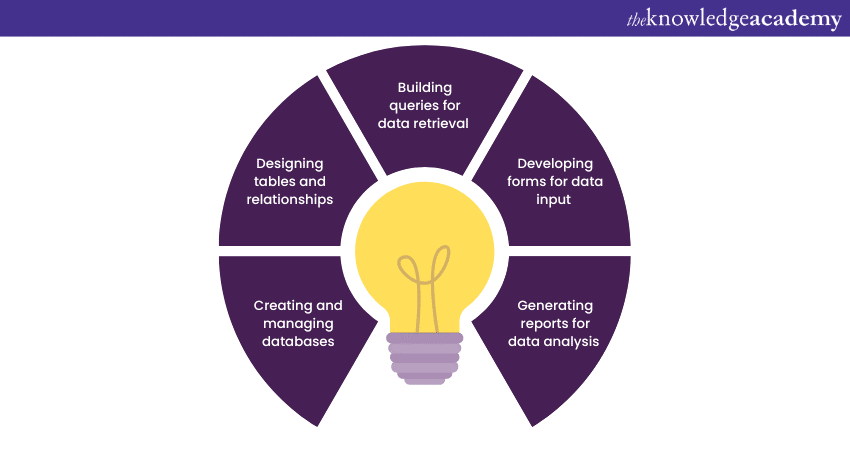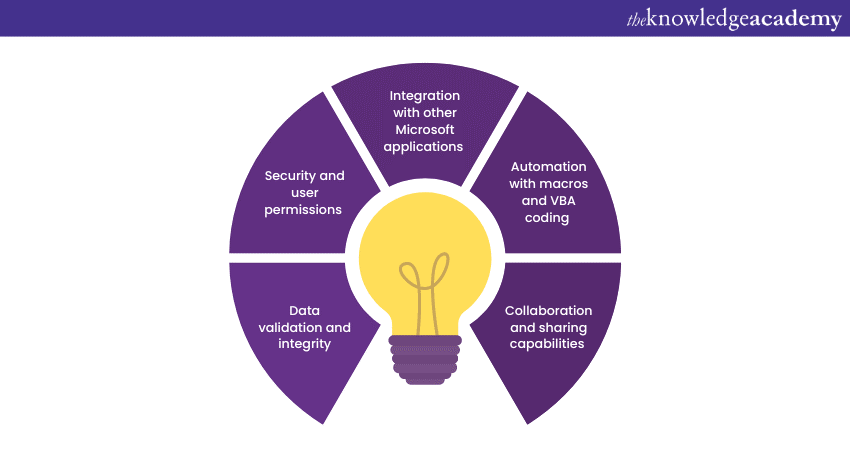We may not have the course you’re looking for. If you enquire or give us a call on 01344203999 and speak to our training experts, we may still be able to help with your training requirements.
We ensure quality, budget-alignment, and timely delivery by our expert instructors.

Microsoft Access is a prevalent Database Management System (DBMS) that provides individuals and organisations with the tools to store, organise, retrieve, and analyse their data effectively. Understanding the functions and features of Microsoft Access is crucial for maximising its potential and improving overall productivity. In this blog, we will explore the various Microsoft Access Functions and features and discuss how it can be used to streamline Data Management processes.
Table of Contents
1) Microsoft Access - An overview
2) Key Microsoft Access Functions
3) Essential Microsoft Access features
4) Best practices for utilising Microsoft Access
5) Conclusion
Microsoft Access - An overview
Before diving into the specific functions and features of Microsoft Access, let's start with a brief overview of what it is and why it is widely used. Access can be described as a Relational Database Management System (RDBMS) that helps create and manage databases, design tables and relationships, build queries, develop forms, and generate reports. It presents a user-friendly interface and tools for data manipulation, and also a paclaged version called microsoft acces runtime making it an ideal choice for individuals and businesses alike.
Access' universal popularity owes itself to the fact that it can handle both small-scale and large-scale Data Management tasks. It presents a flexible and scalable solution that can adapt to the needs of various industries and sectors. Regardless of whether you're a small business owner looking to track inventory or a project manager in need of a database for resource allocation, Microsoft Access can provide the necessary functionality to streamline your operations.
Enhance your Microsoft Access skills with our comprehensive Microsoft Access Masterclass Course!
Key Microsoft Access Functions
Now that we have briefly described What is Microsoft Access, we will look into what are the functions of Microsoft Access. Let us now dive deeper into the key Microsoft Access database

Creating and managing databases
At the core of Microsoft Access is the ability to create and manage databases. With just a few clicks, you can set up a new database file and define its structure. You can create tables, define fields and data types, and establish relationships between tables to ensure data integrity. This function allows you to organise your data in a logical and structured manner, making it simpler to retrieve and analyse information later.
Designing tables and relationships
Tables are known as the building blocks of any database. In Access, you can design tables to store specific types of information, such as customer data, product inventory, or employee records. You can define fields within tables to capture different attributes of the data, such as names, addresses, or dates. Furthermore, you can establish relationships between tables to create meaningful connections and avoid data redundancy.
Building queries for data retrieval
Queries in Access enable you to retrieve specific data from your database based on certain criteria. You can construct queries using a visual interface or by writing SQL (Structured Query Language) statements. Queries allow you to filter, sort, and aggregate data, providing you with customised views of your information. This function is particularly useful when you need to extract specific insights or generate reports based on specific conditions.
Developing forms for data input
Access offers a feature-rich form builder that allows you to create user-friendly interfaces for data input. You can design forms with various controls, such as text boxes, drop-down lists, and checkboxes, to facilitate data entry and validation. Forms can be customised to match your organisation's branding and workflow requirements. They provide a streamlined and intuitive way for users to input and update data within the database.
Generating reports for data analysis
Reports are essential for presenting data in a structured and visually appealing format. In Access, you can generate reports based on your database queries or directly from tables. Reports can include tables, charts, and graphs to illustrate trends, summarise data, or showcase Key Performance Indicators (KPIs). By leveraging the reporting capabilities of Access, you can gain valuable insights and communicate information effectively.
Essential Microsoft Access features
In addition to its core functions, Access offers several essential features that enhance its capabilities and improve data management processes. Let's explore some of these features in more detail.

Data validation and integrity
Maintaining data accuracy and integrity is crucial for any database system. Access provides various tools for data validation, allowing you to enforce rules and constraints on the entered data. You can set field properties, define validation rules, and create input masks to ensure that data is entered correctly and consistently. By implementing data validation, you can minimise errors and improve the quality of your database.
Security and user permissions
Data security is of paramount importance in the modern digital landscape. Access offers robust security features that enable you to control access to your database and protect sensitive information. You can set user permissions at various levels, restricting or granting access to specific tables, queries, forms, and reports. Additionally, you can encrypt your database file to prevent unauthorised access and implement user authentication mechanisms.
Integration with other Microsoft applications
As part of the Microsoft Office suite, Access seamlessly integrates with other applications such as Excel, Word, and Outlook. This integration allows you to share data between different programs, leverage the strengths of each application, and create powerful workflows. For instance, you can import data from Excel spreadsheets into Access tables, perform advanced analysis in Excel, and then export the results back to Access for further processing.
Automation with macros and VBA coding
Access provides automation capabilities through macros and Visual Basic for Applications (VBA) coding. Macros allow you to automate repetitive tasks, such as running queries, generating reports, or updating records. With VBA, you have access to a full-fledged programming language that helps you create custom functionality and extend the capabilities of Access. By harnessing these automation features, you can streamline your workflows and save time.
Collaboration and sharing capabilities
Collaboration is key in many data-driven environments. Access offers features that facilitate collaboration and sharing among multiple users. You can set up a shared database on a network location or use Microsoft 365 to host your database in the cloud. Multiple users can access and update the database simultaneously, enabling real-time collaboration. Furthermore, Access provides tools for tracking changes, resolving conflicts, and managing concurrent access to ensure data consistency.

Best practices for utilising Microsoft Access
Ensure optimal performance to make the most out of Microsoft Access. Therefore, it is important to follow these tips and best practices:
1) Plan and organise: Before creating your database, carefully plan its structure and organise tables, fields, and relationships. This will help you create a logical and efficient Data Management system.
2) Efficient data entry: Adopt efficient data entry techniques to minimise errors and improve productivity. Utilise features like input masks, default values, and validation rules to guide users and ensure data consistency.
3) Regular backups and maintenance: Back up your database regularly to protect against data loss. Schedule routine maintenance tasks, such as compacting and repairing the database, to optimise performance and prevent corruption.
4) Optimise performance: Monitor the performance of your database and take steps to optimise it. Use indexing to improve query performance, avoid storing excessive data in a single table, and periodically analyse query execution plans to identify and resolve bottlenecks.
5) Follow data validation: Implement data validation rules to ensure data accuracy and integrity. Define validation rules, create input masks, and set field properties to enforce data quality.
Start optimizing your use of Microsoft Dynamics 365 today! Download the Microsoft Dynamics 365 User Guide PDF and explore all its features.
Conclusion
In conclusion, Microsoft Access offers a comprehensive solution for efficient data management. By understanding the functions and features of Access, and following the best practices, users can harness the full potential of this database management system. Hope this blog answered all your questions about Microsoft Access Functions and features!
Take your Microsoft Office skills to the next level by signing up for our Microsoft Office Training Courses today!
Upcoming Office Applications Resources Batches & Dates
Date
 Microsoft Word Course
Microsoft Word Course
Fri 2nd May 2025
Fri 4th Jul 2025
Fri 5th Sep 2025
Fri 7th Nov 2025






 Top Rated Course
Top Rated Course


 If you wish to make any changes to your course, please
If you wish to make any changes to your course, please


